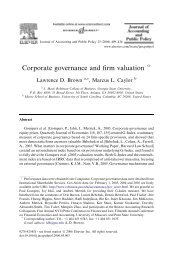Income Dynamics, Economic Rents and the Financialization of the ...
Income Dynamics, Economic Rents and the Financialization of the ...
Income Dynamics, Economic Rents and the Financialization of the ...
You also want an ePaper? Increase the reach of your titles
YUMPU automatically turns print PDFs into web optimized ePapers that Google loves.
<strong>the</strong> banking industry but also a crisis <strong>of</strong> U.S. capitalism. It was also perceived as a failure <strong>of</strong><br />
Keynesian macroeconomic policies which provided no clear explanation or solution for <strong>the</strong><br />
"stagflation" <strong>of</strong> <strong>the</strong> time. We document <strong>the</strong> rise <strong>of</strong> neoliberal policy model <strong>and</strong> <strong>the</strong> solutions pro-<br />
posed to control inflation <strong>and</strong> stimulate <strong>the</strong> finance sector. Lastly, we analyze <strong>the</strong> related devel-<br />
opments in <strong>the</strong> era <strong>of</strong> deregulation to outline <strong>the</strong> systematic reconfiguration <strong>of</strong> <strong>the</strong> U.S. economy.<br />
Problems: Stagflation <strong>and</strong> <strong>the</strong> <strong>Economic</strong> Crisis <strong>of</strong> <strong>the</strong> 1970s<br />
One can point to <strong>the</strong> era around 1980 as a watershed in <strong>the</strong> orientation <strong>of</strong> <strong>the</strong> US federal govern-<br />
ment toward <strong>the</strong> economy in general <strong>and</strong> economic regulation in particular. The economic crises<br />
<strong>of</strong> <strong>the</strong> 1970s centered around <strong>the</strong> OPEC inspired rise in oil prices, <strong>the</strong> perceived rise in union <strong>and</strong><br />
consumer power, <strong>the</strong> end <strong>of</strong> US manufacturing’s global hegemony, <strong>and</strong> <strong>the</strong> birth <strong>of</strong> a low-growth<br />
high-inflation macro-economy. This configuration <strong>of</strong> threats led to <strong>the</strong> mobilization <strong>of</strong> <strong>the</strong> large<br />
firm corporate sector to push for economic deregulation, lower taxes, <strong>and</strong> a smaller state (Miller<br />
<strong>and</strong> Tomaskovic-Devey 1983). These shifts were interpreted at <strong>the</strong> time as a crisis <strong>of</strong> US capital-<br />
ism <strong>and</strong> led to <strong>the</strong> mobilization <strong>of</strong> corporate actors to reinvent <strong>the</strong> system (Vogel 1986). Econom-<br />
ic deregulation in particular was <strong>the</strong> goal <strong>of</strong> <strong>the</strong> business mobilization <strong>of</strong> <strong>the</strong> late 1970s (Useem<br />
1983). During this period <strong>of</strong> recapitalization it is clear that <strong>the</strong> largest banks <strong>and</strong> insurance com-<br />
panies were central to large firm leadership networks (Mintz <strong>and</strong> Schwartz 1985).<br />
In <strong>the</strong> financial sector this crisis was initially defined in terms <strong>of</strong> what came to be called<br />
stagflation --<strong>the</strong> joint occurrence <strong>of</strong> slow or no economic growth <strong>and</strong> high inflation. Slow growth<br />
led to fewer outlets for domestic investment. Inflation undermined <strong>the</strong> traditional banking prac-<br />
tice <strong>of</strong> borrowing money from customers <strong>and</strong> lending it to investors. Stagflation led to a sharp<br />
drop in bank pr<strong>of</strong>itability (see <strong>the</strong> late 1970s in Figures 2 <strong>and</strong> 5). In response, <strong>the</strong> Federal Re-<br />
16







